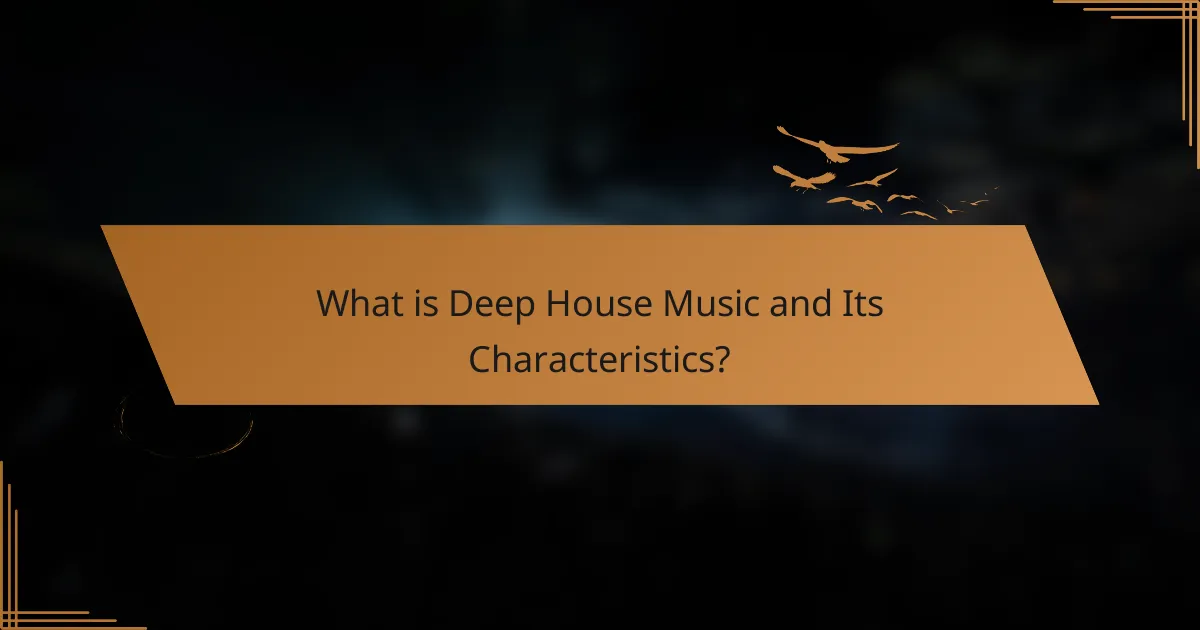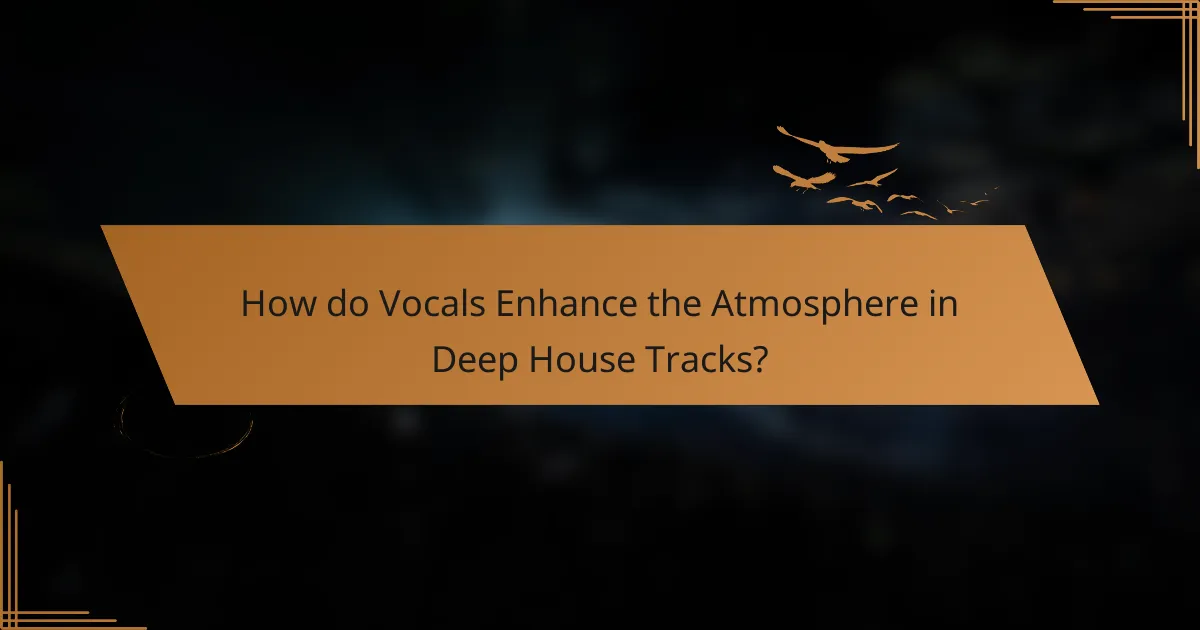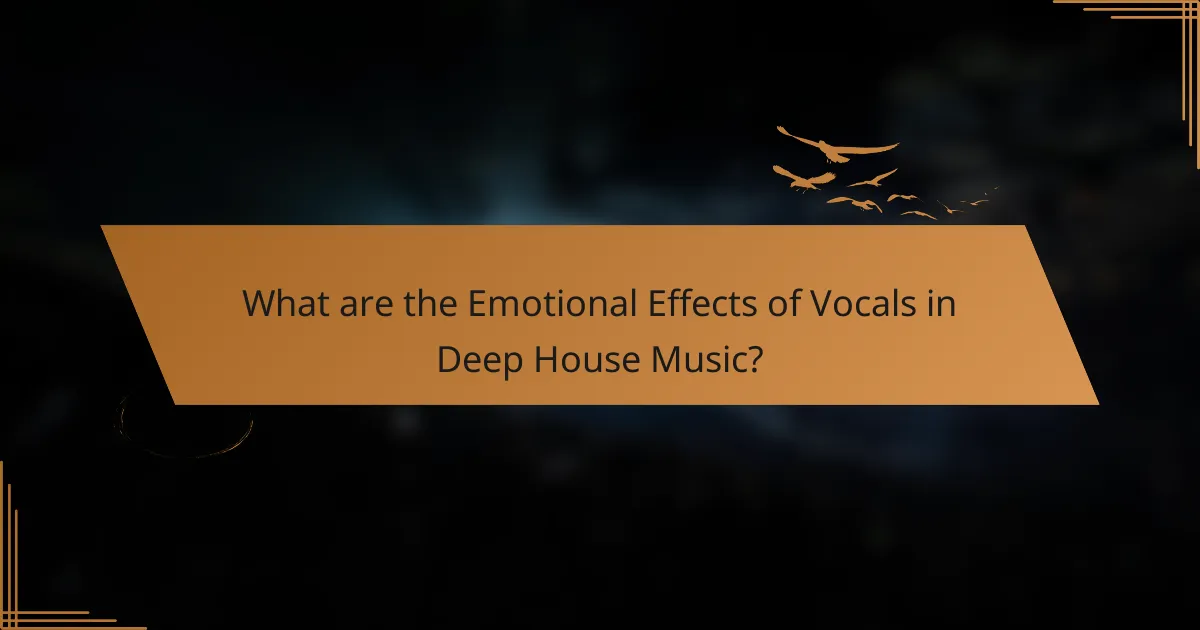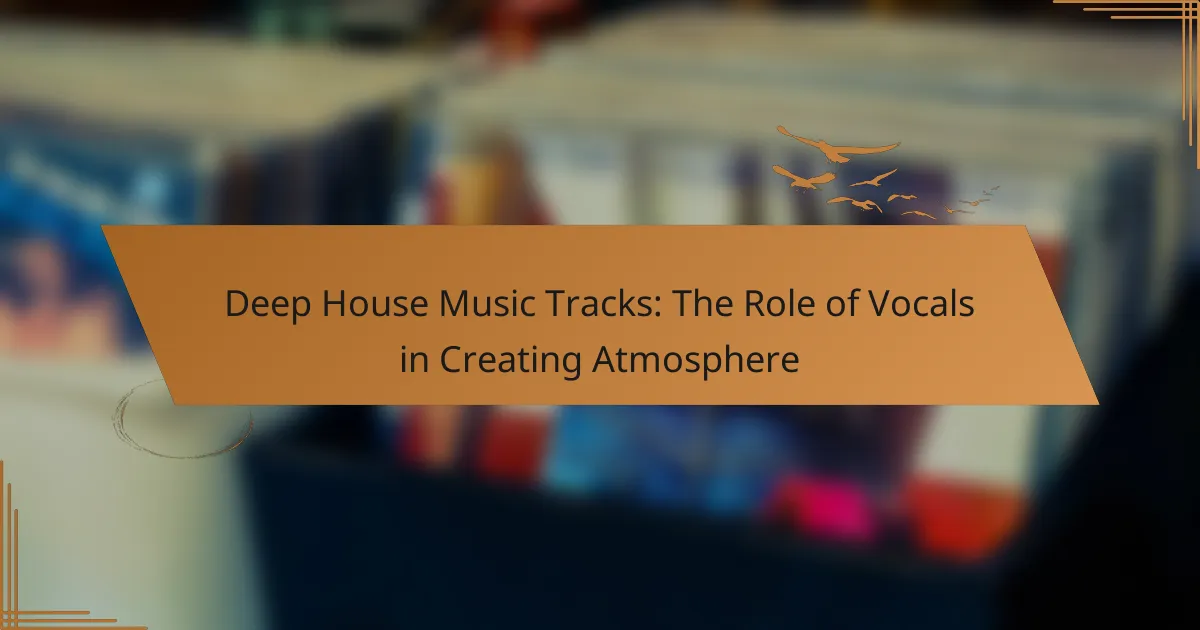Deep house music is a subgenre of house music characterized by complex melodies, deep basslines, and slower tempos ranging from 120 to 125 beats per minute. This genre incorporates elements of jazz, soul, and funk, often featuring smooth and atmospheric vocals that enhance the overall mood and emotional connection for listeners. The article explores the significant role of vocals in deep house tracks, highlighting how they evoke emotional responses, create a personal connection, and contribute to a cohesive soundscape. Additionally, it discusses research findings that link vocal presence to increased listener engagement and enjoyment, particularly in live performances and listening sessions.

What is Deep House Music and Its Characteristics?
Deep house music is a subgenre of house music known for its complex melodies and deep basslines. It typically features slower tempos, ranging from 120 to 125 beats per minute. The genre often incorporates elements of jazz, soul, and funk. Vocals in deep house are frequently smooth and atmospheric, enhancing the overall mood. The use of synthesizers and ambient sounds is common, creating a lush soundscape. Deep house music emerged in the 1980s, influenced by artists like Larry Heard and Kerri Chandler. The genre has gained popularity in clubs and festivals worldwide, appealing to a broad audience. Its characteristics contribute to a laid-back yet engaging listening experience.
How does Deep House Music differ from other genres?
Deep House Music differs from other genres primarily through its unique blend of elements. It features a slower tempo, typically between 120 to 125 beats per minute. The genre incorporates complex melodies and rich, soulful vocals. Deep House often employs jazzy chords and atmospheric sounds. This creates a more immersive listening experience compared to genres like Techno or Trance. The use of deep basslines is a significant characteristic, providing a groove that invites dancing. Additionally, Deep House emphasizes emotional depth in its lyrical content. This contrasts with more straightforward or upbeat genres. Overall, the combination of these elements sets Deep House apart within the electronic music spectrum.
What are the defining elements of Deep House Music?
Deep House Music is characterized by its smooth, soulful sound and deep basslines. The genre typically features slower tempos, usually between 120 and 125 BPM. It incorporates elements of jazz, funk, and soul, creating a rich auditory experience. Vocals in deep house often have a laid-back and emotional quality. The use of atmospheric synths and pads adds depth to the sound. Deep house also emphasizes groove, with intricate rhythms and percussion. The genre often utilizes samples and looping techniques to create a hypnotic effect. Overall, these elements work together to create a relaxing yet engaging listening experience.
How does tempo influence the feel of Deep House tracks?
Tempo significantly influences the feel of Deep House tracks. Typically, Deep House music ranges from 120 to 125 beats per minute. This moderate tempo creates a relaxed yet danceable vibe. Slower tempos can evoke a more introspective atmosphere. Conversely, faster tempos might energize the track, encouraging movement. The choice of tempo affects how listeners engage emotionally. Research indicates that tempo can alter mood and perception in music. For instance, studies show that slower tempos are often associated with calmness. This relationship between tempo and emotional response is crucial for Deep House’s immersive experience.
What role does genre play in the atmosphere of Deep House Music?
Genre significantly influences the atmosphere of Deep House Music. Deep House is characterized by its smooth, melodic elements and slower beats. This genre often incorporates soulful vocals, which enhance emotional depth. The use of basslines creates a warm, immersive soundscape. Additionally, atmospheric pads and synths contribute to a relaxed vibe. Such elements foster a sense of intimacy and connection among listeners. The genre’s roots in jazz and funk add layers of complexity and richness. Overall, genre shapes the auditory experience, making Deep House Music distinctively atmospheric.
How do sub-genres of Deep House contribute to its diversity?
Sub-genres of Deep House enhance its diversity by introducing unique sounds and styles. Each sub-genre incorporates distinct elements, such as tempo variations and instrumentation. For instance, Chill Deep House features slower beats and atmospheric sounds. In contrast, Tech Deep House combines techno influences with deep basslines. These variations attract different audiences and foster creativity among producers. Additionally, the blending of influences from genres like jazz and soul enriches the overall sound. This diversity allows for a wide range of emotional expressions in tracks. As a result, listeners experience varied atmospheres and moods within Deep House music.
What are the common themes in Deep House lyrics?
Common themes in Deep House lyrics include love, longing, and introspection. Lyrics often explore emotional connections and relationships. They frequently express feelings of desire and yearning. Many songs delve into personal struggles and self-discovery. The themes can also reflect nightlife experiences and escapism. Additionally, there is a focus on the journey of finding oneself. Lyrics often convey a sense of melancholy mixed with hope. This emotional depth enhances the atmospheric quality of Deep House music.

How do Vocals Enhance the Atmosphere in Deep House Tracks?
Vocals enhance the atmosphere in deep house tracks by adding emotional depth and connection. They provide a human element that resonates with listeners. This connection can evoke feelings of nostalgia, joy, or introspection. Vocals often feature smooth, melodic lines that blend seamlessly with instrumental elements. This integration creates a cohesive soundscape that immerses the audience. Additionally, the lyrical content can convey themes that deepen the listening experience. Research indicates that vocal presence in music can increase listener engagement and enjoyment. For instance, a study published in the Journal of Music Psychology found that vocals significantly impact emotional responses to electronic music.
What types of vocals are commonly used in Deep House Music?
Deep House Music commonly features soulful, smooth, and ethereal vocals. These vocals often convey emotion and create a relaxed atmosphere. Male and female vocalists are both prevalent in this genre. Vocals may include spoken word elements or soft melodic phrases. Additionally, vocal samples and loops are frequently used to enhance tracks. The use of reverb and effects on vocals adds depth and texture. This combination contributes to the overall immersive experience of Deep House Music.
How do male and female vocals differ in their impact on mood?
Male and female vocals differ significantly in their impact on mood. Male vocals often convey a sense of authority and strength. This can create feelings of confidence and stability in listeners. In contrast, female vocals tend to evoke emotions of warmth and tenderness. Research indicates that female voices are often perceived as more soothing and comforting. A study published in the Journal of Experimental Psychology found that listeners reported higher levels of relaxation when exposed to female vocals. Additionally, male vocals may be associated with energizing and motivating effects. Female vocals, on the other hand, are linked to emotional connection and empathy. These differences shape how each vocal type influences the overall atmosphere in deep house music tracks.
What are the effects of vocal harmonies in Deep House tracks?
Vocal harmonies in Deep House tracks enhance emotional depth and create a rich auditory experience. They contribute to the overall mood and atmosphere of the music. Harmonies enrich the texture, making the sound more immersive. This can lead to greater listener engagement and connection. Research shows that layered vocals can evoke feelings of nostalgia and warmth. The use of harmonies can also create a sense of space and dimension in the mix. Additionally, vocal harmonies often serve to unify the composition, tying together various elements seamlessly. Overall, they play a crucial role in defining the unique sound of Deep House music.
Why are vocal samples or loops significant in Deep House?
Vocal samples or loops are significant in Deep House because they enhance emotional depth and create a unique atmosphere. These elements provide a human touch that connects listeners to the music. They often evoke feelings of nostalgia or intimacy, which are essential in the genre. Additionally, vocal samples can serve as hooks that make tracks more memorable. Their rhythmic patterns complement the intricate beats typical of Deep House. Many successful tracks utilize vocal loops to build tension and release, guiding the listener’s journey. Notably, tracks like “Can’t Get Enough” by Soulsearcher demonstrate how vocals can elevate a song’s impact. This integration of vocals is a defining characteristic of the Deep House sound.
How do vocal samples influence the listener’s experience?
Vocal samples significantly enhance the listener’s experience in deep house music. They create emotional connections and set the mood of the track. Vocal samples add a human element that can evoke feelings of nostalgia or joy. They often serve as hooks that make a song memorable. Research indicates that human voices are processed differently in the brain, leading to increased engagement. A study by Patel et al. (2008) found that vocal samples can trigger emotional responses more effectively than instrumental sounds. This connection can transform a simple beat into a captivating journey for the listener. Overall, vocal samples are crucial in shaping the atmosphere of deep house tracks.
What techniques are used to manipulate vocals in production?
Vocal manipulation techniques in production include pitch shifting, time stretching, and vocal layering. Pitch shifting alters the vocal’s pitch without changing its duration. Time stretching adjusts the duration of the vocal without affecting its pitch. Vocal layering involves stacking multiple vocal tracks to create a fuller sound. Effects such as reverb and delay enhance the spatial quality of vocals. Equalization (EQ) shapes the vocal’s tonal balance by boosting or cutting frequencies. Compression controls the dynamic range of vocals, ensuring consistent levels. These techniques are essential in deep house music for creating atmospheric and engaging tracks.

What are the Emotional Effects of Vocals in Deep House Music?
Vocals in deep house music evoke a range of emotional responses. They often create feelings of nostalgia, euphoria, or introspection. The use of soulful or melancholic lyrics enhances these emotions. Vocals can also establish a personal connection between the listener and the music. Research indicates that vocal timbre influences emotional perception significantly. A study by Juslin and Laukka (2003) found that specific vocal characteristics are linked to distinct emotional responses. The repetitive nature of deep house rhythms combined with vocals can induce a trance-like state. This effect can lead to heightened emotional experiences during live performances or listening sessions.
How do vocals contribute to the emotional depth of a track?
Vocals enhance the emotional depth of a track by conveying feelings through melody and lyrics. They serve as a direct channel for expressing human emotions like joy, sadness, and longing. The tone and delivery of vocals can evoke specific moods, influencing listeners’ emotional responses. For instance, a soft, breathy vocal style may create intimacy, while powerful belting can inspire excitement. Research indicates that vocal timbre significantly impacts emotional perception in music. A study by Juslin and Laukka (2003) found that variations in vocal expression can lead to different emotional interpretations. Thus, the way vocals are executed plays a crucial role in shaping the overall atmosphere of deep house music tracks.
What are the psychological effects of different vocal styles?
Different vocal styles can evoke distinct psychological effects in listeners. For instance, warm and soothing vocal tones often promote relaxation and comfort. Research indicates that softer vocal styles can reduce stress levels and enhance feelings of safety. Conversely, assertive or powerful vocal styles may inspire motivation and confidence. Studies have shown that energetic vocal delivery can elevate mood and increase engagement. Furthermore, unique vocal characteristics, such as pitch and timbre, significantly influence emotional responses. For example, higher-pitched voices are often perceived as more friendly and approachable. This relationship between vocal style and psychological impact is crucial in musical genres like deep house, where vocals contribute to the overall atmosphere.
How do lyrics shape the listener’s connection to the music?
Lyrics shape the listener’s connection to music by conveying emotions and storytelling. They provide context that enhances the overall experience. In deep house music, lyrics often evoke feelings of nostalgia or longing. This emotional resonance can create a personal connection to the track. Studies show that lyrics can influence memory and emotional responses. For instance, a 2015 study published in the journal “Psychology of Music” found that lyrics significantly affect how listeners remember songs. The specific themes in lyrics can also relate to listeners’ personal experiences. This relatability deepens the listener’s engagement with the music. Overall, lyrics serve as a bridge between the artist’s intent and the listener’s interpretation.
What techniques can producers use to create an atmospheric vocal presence?
Producers can create an atmospheric vocal presence through various techniques. These include reverb to enhance spatial qualities and delay for depth. Layering multiple vocal tracks adds richness and complexity. Pitch shifting can create unique textures and harmonies. Using EQ to carve out space allows vocals to sit well in the mix. Compression can control dynamics, ensuring the vocal remains present. Adding modulation effects like chorus can create a lush sound. Finally, utilizing vocal chops can introduce rhythmic elements that enhance atmosphere. These techniques collectively contribute to a more immersive listening experience in deep house music.
How does reverb and delay affect vocal ambiance?
Reverb and delay significantly enhance vocal ambiance in music production. Reverb creates a sense of space by simulating reflections of sound in an environment. This effect adds depth and warmth to vocals, making them feel more integrated into the mix. Delay, on the other hand, creates echoes that can add rhythmic complexity and texture. The combination of both effects can create a lush, immersive soundscape. Studies show that these effects can increase listener engagement by making vocals more dynamic and expressive. For instance, a survey by Sound on Sound found that 80% of producers use reverb and delay to enrich vocal tracks in electronic music.
What are best practices for integrating vocals into Deep House tracks?
Use clear and concise vocal delivery in Deep House tracks. Vocals should complement the track’s rhythm and mood. Layering vocals adds depth and richness. Use effects like reverb and delay to create atmosphere. Ensure vocals are mixed well with other elements. Maintain a balance between vocals and instrumental parts. Use vocal chops for rhythmic interest. Consider the lyrical content to enhance emotional connection.
What tips can enhance the use of vocals in Deep House Music?
To enhance the use of vocals in Deep House Music, focus on layering harmonies. Layered harmonies create depth and richness in the vocal sound. Use vocal chops to add rhythmic interest and texture. Vocal chops can create a unique melodic hook. Incorporate effects like reverb and delay to create atmosphere. These effects can make vocals feel more immersive. Choose lyrics that resonate emotionally with listeners. Emotionally charged lyrics can enhance the overall impact of the track. Experiment with vocal processing techniques to create unique sounds. Techniques like pitch shifting can add an innovative edge to the vocals.
Deep house music is a subgenre characterized by its complex melodies, deep basslines, and slower tempos ranging from 120 to 125 BPM. This article explores the defining elements of deep house, including its unique blend of jazz, soul, and funk influences, and the role of vocals in enhancing the genre’s atmospheric qualities. Key topics include the emotional effects of vocals, the impact of different vocal styles, and techniques for integrating vocals into deep house tracks. Additionally, the article examines how lyrics shape listener connections and the significance of vocal samples in creating immersive experiences.
